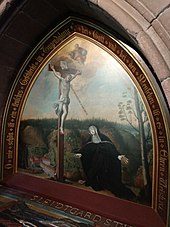Wittichen Monastery
The monastery Wittichen is a former Clarisse convent in Wittichen in a narrow side valley of the Little Kinzig in Schenkenzell in the upper Kinzigtal in the Black Forest .
history
The monastery was founded by the blessed Luitgard von Wittichen in 1324. According to tradition, according to the Luitgard, who came from the Schenkenzell district of Kaltbrunn-Vortal, God said at the place of the monastery: "Here you should build me a house!" So she went looking for fellow sisters and founded her monastery with 33 sisters in the wasteland of Wittichen. The ideal religious center of the nuns' community, which adopted the Poor Clares rule in 1376, was the grave of Blessed Luitgard. Pilgrimages were made to her grave, especially after the grave was opened in 1629 - the brain of the dead was found to be completely intact.
The monastery found support in the dukes of Teck and the counts of Geroldseck as well as by Queen Agnes of Hungary . Through their mediation the hermitage of Pope Johannes XXII. recognized as a monastery. After difficult beginnings (fire of the monastery in 1327, consecration of the monastery church in 1330), a women's community with extensive monastery property in Wittichen and Kaltbrunn as well as on the Upper Rhine and Neckar (Schaffneien for property management in Gengenbach, among others) developed on Geroldsecker property below Wittichenstein Castle and guarded by the counts , Horb, Lahr, Rottweil, Strasbourg, Villingen).
Suspended temporarily in 1540 as a result of the Reformation, the women's convention was consolidated again - albeit with limited options - and suffered heavy losses in the Thirty Years' War (1618–1648) and thereafter (1640, 1663).
The monastery was secularized in 1803 . During the secularization, the monastery came into the possession of the Fürstenberg Princely House . Part of the building was demolished in the 1850s because of the high cost. The church, the nave and the monastery stable have been preserved, as has the cemetery.
Worth seeing
The monastery church is a baroque gem and is still the destination of many pilgrims today. Here is Luitgard's grave and among other things a grave slab with the coat of arms of the von Urslingen family .
A small museum has been set up in the old monastery stable, which exhibits treasures such as the monstrance , vestments and similar items of equipment from the monastery, as well as minerals from Wittichen. Four early modern musical instruments from the monastery have been preserved in the Basel Historical Museum.
The nave of the monastery building, which is impressive from the outside due to its thickness, is used by the village of Kaltbrunn as a community center. The building effectively seals off the small valley. The Talbach and the thoroughfare lead side by side through two sandstone-lined gates in the building to the former mining settlement of Wittichen. The whole complex looks extremely idyllic despite its incompleteness.
literature
- The art monuments of the Grand Duchy of Baden Vol. 7: The art monuments of the Offenburg district . Tübingen 1908, pp. 624-633 Heidelberg University Library .
- Ludwig Heizmann: The little nunnery in Wittichen. Office Wolfach in the Kinzigtal. For the six hundred year anniversary . Bühl (Baden) 1925 Freiburg University Library .
- Johannes Gatz: Wittichen / Black Forest. Terziarinnen - Poor Clares . In: Alemannia Francicana Antiqua 18 (1973), pp. 127–242 (only the bibliography in the Internet Archive )
- Josef Krausbeck: The Wittichen monastery in the Black Forest . In: Die Ortenau 58 (1978), pp. 455-469 UB Freiburg .
- Werner Scheurer: Wittichen. All Saints' Day, Catholic parish church, former monastery church (small art guide). Regensburg 1996. ISBN 978-3-7954-5698-6 .
- Stephanie Zumbrink, Stefan King: Wittichen. Former monastery church (small art guide). Regensburg 2017. ISBN 978-3-7954-7066-1 .
- The Rottweil district . Edited by the Baden-Württemberg State Archives Directorate. Vol. 2, Ostfildern 2003, p. 156f.
- Stefan King: The monastery church of the Blessed Luitgard in Wittichen. A medieval building in a baroque guise . In: Nachrichtenblatt der Denkmalpflege in Baden-Württemberg 44 (2015), pp. 139–143 doi : 10.11588 / nbdpfbw.2015.3.23402
- Bert Roest: Order and Disorder. The Poor Clares between Foundation and Reform . Leiden / Boston 2013, p. 145 ISBN 9004244751 .
- Stefan Benz: women's monastery in Central Europe. Directory and description of their historical culture 1550-1800 . Münster 2014, p. 695 ISBN 978-3-402-11584-8 .
Web links
- Wittichen Monastery in the database of monasteries in Baden-Württemberg of the Baden-Württemberg State Archives
- Wittichen Abbey on the website of the community of Schenkenzell
Individual evidence
- ^ Klaus Graf : Early modern musical instruments from Wittichen Abbey in the Basel Historical Museum . In: Archivalia of October 15, 2018 .
Coordinates: 48 ° 20 ′ 5.3 " N , 8 ° 20 ′ 48.8" E




